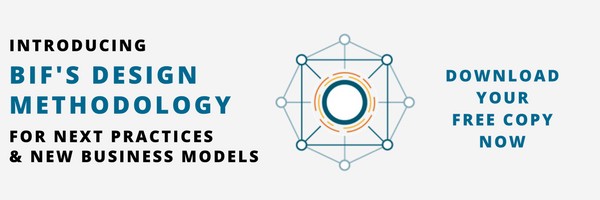Converting Emerging Tech into Next Practices
To appreciate the full breadth of possibility created by emerging technologies is to feel like a kid in a candy store. Our candy store is overflowing with brain-exploding and exciting new technologies including genomics, robotics, internet-of-things, big data, artificial intelligence, drones, and 3D printing to name just a few.
Any one or combination of these emerging technologies has the potential to change the world. Whether they will or not, and at what pace, depends on our ability to combine and recombine emerging technologies into next practices and new business models to solve the important social challenges of our time.
Why do companies fail at turning emerging technologies into real value?
Reason no. 1 for failure is infatuation with technology instead of the business problem that needs to be solved. Many human beings in the corporate world fall in love with bright new shiny objects and then try to force-fit the business problem to their favored technology.
As the saying goes, “When the only tool you have is a hammer, every problem looks like a nail.†It’s usually after the initial glow wears off and millions of dollars have been burnt in the innovation bonfire that organizations realize they are not any closer to seeing results than they were 12 months back.
The key to successful innovation is accepting that not every technology is right for your business. Selecting the right technology requires steely-eyed focus and clarity of purpose. Instead of pondering whether AI or VR is the “best†or “coolest†technology, you should be asking, “Which new technology will help my business stay competitive and relevant over the next 100years?â€
Another reason why companies fail at meaningful innovation is they invest in areas that are unrelated to their core competency or business.
It’s like a tire company investing in an AI-powered skateboard, which doesn’t make them more relevant or add more value to their target audience. Smart companies invest in adjacent and synergistic categories to stay competitive. Lately, there has been a flurry of innovation labs and incubators at global companies who are trying to stay relevant in a very disruptive age, but innovating in a silo doesn’t help the organization break old business models.
The innovation model must have connectors to existing parts of the business and leverage strengths wherever possible. The most devastating threat to adoption of new technologies and innovative business models is a legacy company culture that is fiercely resistant to change.
An organization’s attitude towards change and willingness to adopt new ways of doing things can make or break the most promising innovation program.
How can you create an innovation-centered mind shift in a legacy organization?

Transformation is a team sport. It requires a shared language. Very often the same people who are tapped for running innovation are folks who have experience with the company but have zero expertise driving innovation. They stifle innovation.
Today’s corporate innovation strategies and approaches are organized to produce tweaks to today’s business model. The new corporate innovation imperative is to do ongoing R&D for next practices and new business models.
Emerging technologies don’t deliver value in the real world until they’re converted into capabilities. If they’re constrained by the straightjacket of today’s business model, they will deliver tweaks at best.
Emerging technologies don’t deliver transformational value until they’re converted into next practices and either integrated into today’s business model or leveraged to launch entire new business models.
Understanding the promise of emerging technologies is an important first step but their transformational promise will never be realized without innovation strategies and approaches to go beyond incremental change to the way things work today. It’s not the technology that is getting in our way, it’s us. Stubborn humans and organizations that through around all the innovation buzzwords but then constrain the exploration and development of transformational next practices and new business models.
8 key steps to explore, test, and commercialize next practices and new business models.Â
1.      Focus on business problem you are trying to solve rather than the technology itself so you can generate maximum value for your business.
2.      Stop innovating in silos and build connectors to other parts of your existing business so you can leverage current strengths and competencies.
3.      Have a well-thought-out plan for scaling innovation by acknowledging and preparing for the various constraints within, across and outside of the organization.
4.      Hire catalysts and enablers rather than familiar faces to turn innovation into opportunity.
5.      Transformation starts when you ‘Shift†your lens to see opportunities from the perspective of customer experience and jobs-to-be-done.
6.      Customer experience provides the best foundation for the ‘Conceptual Design’ of a next practice or new business model.
7.      The only way to know if a design concept will survive customer contact is to ‘Prototype and Test’ it in the real world.
8.      To successfully ‘Commercialize’ next practices and new business models, start with a market-tested Minimum Viable Business Model.
In conclusion, turning technology buzzwords into real business capabilities takes focus and discipline. Innovation is a marathon, not a sprint and the real business value is realized long after the glamor of a new bright shiny object has worn off.
image credit: MIT technology review 2017; marketoonist.com

About the Authors:
 Saul Kaplan is the Founder and Chief Catalyst at Business Innovation Factory. His mission is to enable collaborative innovation and contribute to a more prosperous local and national economy and to catalyze business model innovation in healthcare, education, public safety, and consumer experience. Follow @skap5
Saul Kaplan is the Founder and Chief Catalyst at Business Innovation Factory. His mission is to enable collaborative innovation and contribute to a more prosperous local and national economy and to catalyze business model innovation in healthcare, education, public safety, and consumer experience. Follow @skap5
 Mia Dand is the CEO of Lighthouse3.com, a Digital Strategy & Research Advisory firm based in the San Francisco Bay Area. Mia has built and led digital/social media programs for world’s best-known brands including Google, Symantec, HP, eBay and others. Her firm Lighthouse3.com authored the first definitive guide for Influencer Technology, downloadable here.
Mia Dand is the CEO of Lighthouse3.com, a Digital Strategy & Research Advisory firm based in the San Francisco Bay Area. Mia has built and led digital/social media programs for world’s best-known brands including Google, Symantec, HP, eBay and others. Her firm Lighthouse3.com authored the first definitive guide for Influencer Technology, downloadable here.
NEVER MISS ANOTHER NEWSLETTER!
LATEST BLOGS
How Brexit Has Affected UK E-commerce Businesses
Photo by Zyro on Unsplash The popularity of online shopping was already growing at an impressive rate – and…
Read MoreOvercoming range anxiety: three tips for EV owners
Photo by Jenny Ueberberg on Unsplash In the last few years, electric vehicles (EVs) have become more and more…
Read More



